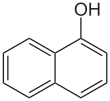1-Naphthol
| |||
| Names | |||
|---|---|---|---|
| Preferred IUPAC name
Naphthalen-1-ol | |||
| Other names
1-Hydroxynaphthalene; 1-Naphthalenol; α-Naphthol
| |||
| Identifiers | |||
3D model (JSmol)
|
|||
| 1817321 | |||
| ChEBI | |||
| ChEMBL | |||
| ChemSpider | |||
| ECHA InfoCard | 100.001.791 | ||
| EC Number |
| ||
| 69192 | |||
| KEGG | |||
PubChem CID
|
|||
| UNII | |||
CompTox Dashboard (EPA)
|
|||
| |||
| |||
| Properties | |||
| C10H8O | |||
| Molar mass | 144.17 g/mol | ||
| Appearance | Colorless or white solid | ||
| Density | 1.10 g/cm3 | ||
| Melting point | 95 to 96 °C (203 to 205 °F; 368 to 369 K) | ||
| Boiling point | 278 to 280 °C (532 to 536 °F; 551 to 553 K) | ||
| -98.2·10−6 cm3/mol | |||
| Hazards | |||
| GHS labelling:[1] | |||
   
| |||
| Danger | |||
| H302, H311, H312, H315, H317, H318, H335, H410, H412 | |||
| P261, P262, P264, P264+P265, P270, P271, P272, P273, P280, P301+P317, P302+P352, P304+P340, P305+P354+P338, P316, P317, P319, P321, P330, P332+P317, P333+P317, P361+P364, P362+P364, P391, P403+P233, P405, P501 | |||
Except where otherwise noted, data are given for materials in their standard state (at 25 °C [77 °F], 100 kPa).
| |||
1-Naphthol, or α-naphthol, is a organic compound with the formula C10H7OH. It is a fluorescent white solid. 1-Naphthol differs from its isomer 2-naphthol by the location of the hydroxyl group on the naphthalene ring. The naphthols are naphthalene homologues of phenol. Both isomers are soluble in simple organic solvents. They are precursors to a variety of useful compounds.[2]
Production
[edit]1-Naphthol is prepared by two main routes.[2] In one method, naphthalene is nitrated to give 1-nitronaphthalene, which is hydrogenated to the amine followed by hydrolysis:
- C10H8 + HNO3 → C10H7NO2 + H2O
- C10H7NO2 + 3H2 → C10H7NH2 + 2H2O
- C10H7NH2 + H2O → C10H7OH + NH3
Alternatively, naphthalene is hydrogenated to tetralin, which is oxidized to 1-tetralone, which undergoes dehydrogenation.
Reactions
[edit]Some reactions of 1-naphthol are explicable with reference to its tautomerism, which produces a small amount of the keto tautomer.[citation needed]
One consequence of this tautomerism is the Bucherer reaction, the ammonolysis of 1-naphthol to give 1-aminonaphthalene.
1-Naphthol biodegrades via formation of 1-naphthol-3,4-oxide, which converts to 1,4-naphthoquinone.[3]
The 4-position of 1-naphthol is susceptible to electrophilic attack. This regioselective reaction is exploited in the preparation of diazo dyes, which are form using diazonium salts. Reduction of the diazo derivatives gives 4-amino-1-naphthol.[4][5]
Partial reduction of 1-naphthol gives the tetrahydro derivative, leaving intact the phenol ring.[6] Full hydrogenation is catalyzed by rhodium.[7]
Applications and occurrence
[edit]1-Naphthol is a precursor to a variety of insecticides including carbaryl and pharmaceuticals including nadolol[8][9] as well as for the antidepressant sertraline[10] and the anti-protozoan therapeutic atovaquone.[11] It undergoes azo coupling to give various azo dyes, but these are generally less useful than those derived from 2-naphthol.[2][12]
1-Naphthol is a metabolite of the insecticide carbaryl and naphthalene. Along with TCPy, it has been shown to decrease testosterone levels in adult men.[13]
Other uses
[edit]1-Naphthol is used in each of the following chemical tests, which predate the use of spectroscopic and chromatographic methods:
- Molisch's test gives a red- or purple-colored compound to indicate the presence of carbohydrate.
- rapid furfural test turns purple quickly (<30s) if fructose is present, distinguishing it from glucose.
- Sakaguchi test turns red to indicate the presence of arginine in proteins.
- Voges–Proskauer test changes color from yellow to red to indicate that glucose is being broken down into acetoin which is used by bacteria for external energy storage.
Safety
[edit]1-Naphthol has been described as "moderately toxic".[2]
References
[edit]- ^ "1-Naphthol". pubchem.ncbi.nlm.nih.gov.
- ^ a b c d Booth, Gerald (2005). "Naphthalene Derivatives". Ullmann's Encyclopedia of Industrial Chemistry. Weinheim: Wiley-VCH. doi:10.1002/14356007.a17_009. ISBN 978-3527306732.. full-text PDF
- ^ Yoshito Kumagai; Yasuhiro Shinkai; Takashi Miura; Arthur K. Cho (2011). "The Chemical Biology of Naphthoquinones and Its Environmental Implications". Annual Review of Pharmacology and Toxicology. 52: 221–47. doi:10.1146/annurev-pharmtox-010611-134517. PMID 21942631.
- ^ J. B. Conant; R. E. Lutz; B. B. Corson (1923). "1,4-Aminonaphthol Hydrochloride". Organic Syntheses. 3: 7. doi:10.15227/orgsyn.003.0007.
- ^ Louis F. Fieser (1937). "1,2-Aminonaphthol Hydrochloride". Organic Syntheses. 17: 9. doi:10.15227/orgsyn.017.0009.
- ^ C. David Gutsche; Hugo H. Peter (1957). "Ar-Tetrahydro-a-Naphthol". Organic Syntheses. 37: 80. doi:10.15227/orgsyn.037.0080.
- ^ A. I. Meyers; W. N. Beverung; R. Gault (1971). "Hydrogenation of Aromatic Nuclei: 1-Decalol". Organic Syntheses. 51: 103. doi:10.15227/orgsyn.051.0103.
- ^ M.E. Condon; et al. (1978). "Nondepressant β-adrenergic blocking agents. 1. Substituted 3-amino-1-(5,6,7,8-tetrahydro-1-naphthoxy)-2-propanols". Journal of Medicinal Chemistry (in German). 21 (9): 913–922. doi:10.1021/jm00207a014. PMID 31485.
- ^ DE 2258995, F.R. Hauck, C.M. Cimarusti, V.L. Narayan, "2,3-cis-1,2,3,4-Tetrahydro-5[2-hydroxy-3-(tert.-butylamino)-propoxy]-2,3-naphthalindiol", published 1973-06-07, assigned to E.R. Squibb & Sons, Inc.
- ^ K. Vukics; T. Fodor; J. Fischer; I. Fellevári; S. Lévai (2002), "Improved industrial synthesis of antidepressant Sertraline", Org. Process Res. Dev. (in German), vol. 6, no. 1, pp. 82–85, doi:10.1021/op0100549
- ^ B.N. Roy; G.P. Singh; P.S. Lathi; M.K. Agarwal (2013). "A novel process for synthesis of Atovaquone" (PDF). Indian J. Chem. (in German). 52B: 1299–1312. Archived from the original (PDF) on 30 May 2022.
- ^ C. Kaiser; T. Jen; E. Garvey; W.D. Bowen; D.F. Colella; J.R. Wardell Jr. (1977). "Adrenergic agents. 4. Substituted phenoxypropanolamine derivatives as potential β-adrenergic agonists". Journal of Medicinal Chemistry (in German). 20 (5): 687–689. doi:10.1021/jm00215a014. PMID 16136.
- ^ Meeker, John D.; Ryan, Louise; Barr, Dana B.; Hauser, Russ (January 2006). "Exposure to Nonpersistent Insecticides and Male Reproductive Hormones". Epidemiology. 17 (1): 61–68. doi:10.1097/01.ede.0000190602.14691.70. PMID 16357596. S2CID 24829926.
External links
[edit]- NIST Chemistry WebBook 1-Naphthalenol
- . Encyclopædia Britannica. Vol. 19 (11th ed.). 1911. pp. 168–169.



